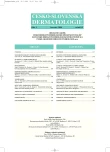Autoimmune Bullous Dermatoses
Authors:
P. Cetkovská
Authors‘ workplace:
Dermatovenerologická klinika FN a LFUK v Plzni
přednosta prof. MUDr. V. Resl, CSc.
Published in:
Čes-slov Derm, 81, 2006, No. 4, p. 188-198
Category:
Reviews (Continuing Medical Education)
Overview
The bullous dermatoses comprise the congenital bullous dermatoses and acquired autoimmune diseases. Autoimmune bullous dermatoses are characterized by relatively stable clinical, histopathological and immunopathological findings. They arise on the basis of specific autoimmune reactions either with desmosomal or basement membrane molecules. According to the site of blister formation they are divided into intraepidermal and subepidermal bullous diseases. These serious conditions cause high morbidity and mortality and therefore require a long-term treatment. Newly developed molecular-biologic techniques help to better understand their pathophysiology, establish the precise diagnosis and thus to choose the proper effective treatment.
Key words:
autoimmune bullous diseases – pemphigus – pemphigoid – epidermolysis bullosa acquisita – dermatitis herpetiformis – linear IgA dermatosis
Labels
Dermatology & STDs Paediatric dermatology & STDsArticle was published in
Czech-Slovak Dermatology

2006 Issue 4
Most read in this issue
- Autoimmune Bullous Dermatoses
- Merkel Cells in Adnexal Neoplasias of Skin
- Deep Vein Thrombosis of Lower Limbs
- Photometrical Device for Measurement of Skin Surface Roughness
